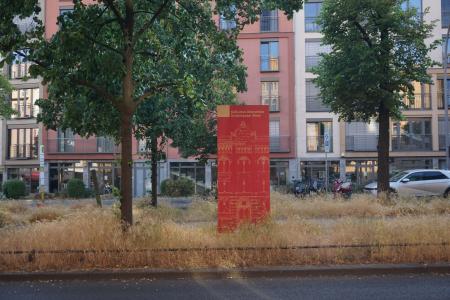Obj. ID: 30196
Jewish Architecture Holocaust memorial plaque at the Alms house (Altersheim Schönhauser Allee) in Berlin, Germany, 2015
To the main object: Alms house (Altersheim Schönhauser Allee) in Berlin, Germany

Name of Monument
No official name
Who is Commemorated?
Jewish Old Age Home and residents deported to Theresienstadt / Terezin.
Description
A plaque with a stainless steel frame is affixed to left of the entrance.
Inscriptions
BERLINER GEDENKTAFEL
In diesem Gebäude befand sich seit 1883 die
ZWEITE JÜDISCHE
VERSORGUNGSANSTALT
Gegründet von dem Philanthropen Mortiz Manheimer
Wurde das Altersheim im Beisein der Kaiserin Augusta eröffnet
Mittellose Juden konnten hier ihren Lebensabend verbringen
Sofern sie mindestens 15 Jahre in Berlin gelebt hatten
Die letzten Bewohner und das Personal des Alterscheims
Wurden 1943 in das Ghetto Theresienstadt deportiert
Translation: Berlin Memorial Plaque / In this building existed from 1883, the / SECOND JEWISH PENSION INSTITUTION / Founded by philanthropist Moritz Manheimer, the retirement home was opened in the presence of Empress Augusta. Destitute Jews could spend their old age here if they had lived in Berlin for at least 15 years. The last residents and the staff of the retirement home were deported to the Theresienstadt ghetto in 1943.
Commissioned by
to be determined
sub-set tree:
stainless steel
The home was founded by philanthropists Bertha (1837-1918) and Moritz Mannheimer (1827- 1916) in 1883 as a retirement home for needy Jews who had reached the age of 60 and had lived in Berlin for at least 15 years. Twelve residents moved in. Originally, the home had 12 rooms for residents on two floors and featured a small synagogue, meeting room, kitchen, store, laundry, ironing room, boiler room, and an apartment of the home inspector. The demand was great, so the home was expanded, first in 1887 and then in 1892, when a reading room with a library was added and space for 80 boarders was provided. The Home was mainly financed by donations.
In 1942 the Nazis closed the home and the majority of the boarders, and their helpers were transported to Theresienstadt in 1943, where most met their deaths or were further transported to Auschwitz. The Nazis took over the building and afterward it was occupied by the East German police until after reunification.
The plaque was installed on the exterior wall of the former Jewish Old Age Home in 2015. A commemorative stele with additional historical information was added in the median of Schönhauser Allee on October 30, 2015.
The Street View in Google Maps captured in April 2022 show that the stele with additional historical information was covered with graffiti.
“Berliner Gedenktafel,”
Wikipedia, https://de.wikipedia.org/wiki/Berliner_Gedenktafel.
“Jüdisches Altersheim / The Jewish Old People's Home,”
Kultur- und Tourismusmarketing Berlin-Pankow, https://www.pankow-weissensee-prenzlauerberg.berlin/en/judisches-altersheim., https://www.pankow-weissensee-prenzlauerberg.berlin/ (accessed April 10, 2024)






